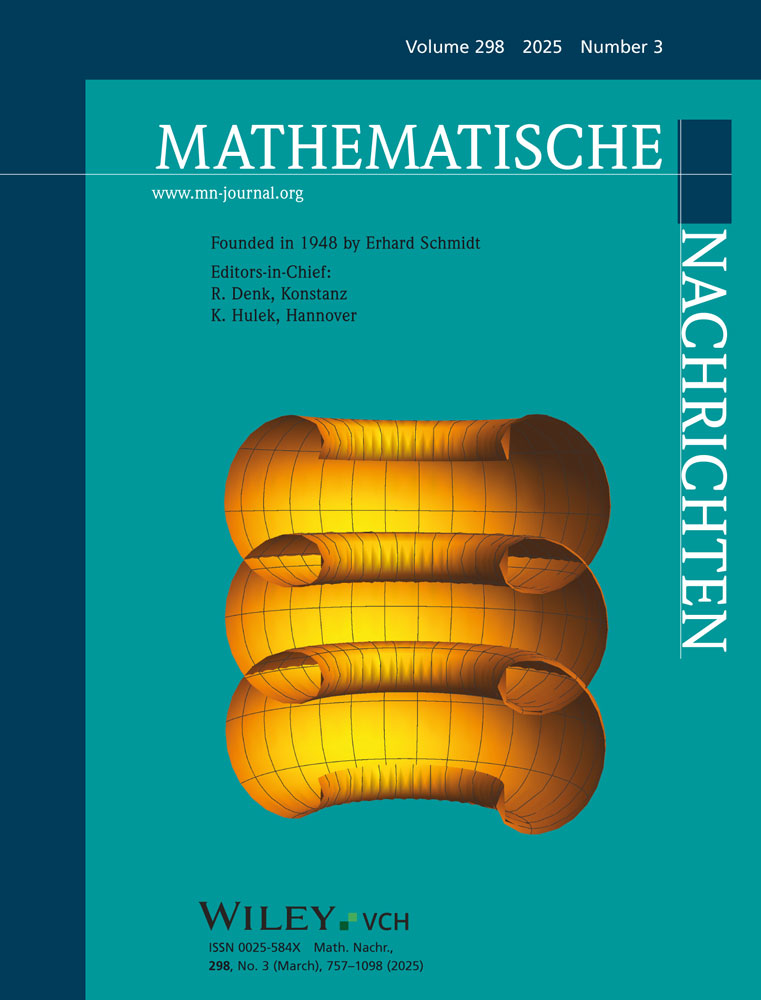Sharp convergence rate on Schrödingertype operators
Meng Wang
School of Mathematical Sciences, Zhejiang University, Hangzhou, P. R. China
Search for more papers by this authorCorresponding Author
Shuijiang Zhao
School of Mathematical Sciences, Zhejiang University, Hangzhou, P. R. China
Correspondence
Shuijiang Zhao, School of Mathematical Sciences, Zhejiang University, Hangzhou 310058, P. R. China.
Email: [email protected]
Search for more papers by this authorMeng Wang
School of Mathematical Sciences, Zhejiang University, Hangzhou, P. R. China
Search for more papers by this authorCorresponding Author
Shuijiang Zhao
School of Mathematical Sciences, Zhejiang University, Hangzhou, P. R. China
Correspondence
Shuijiang Zhao, School of Mathematical Sciences, Zhejiang University, Hangzhou 310058, P. R. China.
Email: [email protected]
Search for more papers by this authorAbstract
For Schrödinger-type operators in one dimension, we consider the relationship between the convergence rate and the regularity for initial data. By establishing the associated frequency-localized maximal estimates, we prove sharp results up to the endpoints. The optimal range for the wave operator in all dimensions is also obtained.
REFERENCES
- 1J. Bourgain, Some new estimates on oscillatory integrals, Essays on Fourier analysis in honor of Elias M. Stein (Princeton, NJ, 1991), Princeton Math. Ser., vol. 42, Princeton Univ. Press, Princeton, NJ, 1995, pp. 83–112.
10.1515/9781400852949.83 Google Scholar
- 2J. Bourgain, On the Schrödinger maximal function in higher dimension, Tr. Mat. Inst. Steklova. 280 (2013), 53–66.
- 3J. Bourgain, A note on the Schrödinger maximal function, J. Anal. Math. 130 (2016), 393–396.
- 4Z. Cao, D. Fan, and M. Wang, The rate of convergence on Schrödinger operator, Illinois J. Math. 62 (2018), no. 1-4, 365–380.
10.1215/ijm/1552442667 Google Scholar
- 5L. Carleson, Some analytic problems related to statistical mechanics, Euclidean harmonic analysis (Proc. Sem., Univ. Maryland, College Park, Md., 1979), Lecture Notes in Math., vol. 779, Springer, Berlin, 1980, pp. 5–45.
10.1007/BFb0087666 Google Scholar
- 6C.-H. Cho and H. Ko, Pointwise convergence of the fractional Schrödinger equation in , Taiwanese J. Math. 26 (2022), no. 1, 177–200.
10.11650/tjm/210904 Google Scholar
- 7M. G. Cowling, Harmonic analysis on semigroups, Ann. Math. (2) 117 (1983), no. 2, 267–283.
10.2307/2007077 Google Scholar
- 8M. G. Cowling, Pointwise behavior of solutions to Schrödinger equations, Harmonic analysis (Cortona, 1982), Lecture Notes in Math., vol. 992, Springer, Berlin, 1983, pp. 83–90.
10.1007/BFb0069152 Google Scholar
- 9B. E. J. Dahlberg and C. E. Kenig, A note on the almost everywhere behavior of solutions to the Schrödinger equation, Harmonic analysis (Minneapolis, Minn., 1981), Lecture Notes in Math., vol. 908, Springer, Berlin-New York, 1982, pp. 205–209.
10.1007/BFb0093289 Google Scholar
- 10E. Dimou and A. Seeger, On pointwise convergence of Schrödinger means, Mathematika, 66 (2020), no. 2, 356–372.
10.1112/mtk.12025 Google Scholar
- 11X. Du, L. Guth, and X. Li, A sharp Schrödinger maximal estimate in , Ann. Math. (2), 186 (2017), no. 2, 607–640.
- 12X. Du and R. Zhang, Sharp estimates of the Schrödinger maximal function in higher dimensions, Ann. Math. (2), 189 (2019), no. 3, 837–861.
10.4007/annals.2019.189.3.4 Google Scholar
- 13L. Grafakos, Classical Fourier analysis, Graduate Texts in Mathematics, vol. 249, 3rd ed., Springer, New York, 2014.
10.1007/978-1-4939-1194-3 Google Scholar
- 14S. Ham, H. Ko, and S. Lee, Dimension of divergence set of the wave equation, Nonlinear Anal. 215 (2022), Paper No. 112631, 10.
10.1016/j.na.2021.112631 Google Scholar
- 15C. E. Kenig and A. Ruiz, A strong type estimate for a maximal operator associated to the Schrödinger equation, Trans. Amer. Math. Soc. 280 (1983), no. 1, 239–246.
- 16S. Lee, On pointwise convergence of the solutions to Schrödinger equations in , Int. Math. Res. Not. 2006 (2006), no. 22, 21, Art. ID 32597.
- 17R. Lucà and K. M. Rogers, A note on pointwise convergence for the Schrödinger equation, Math. Proc. Cambridge Philos. Soc. 166 (2019), no. 2, 209–218.
10.1017/S0305004117000743 Google Scholar
- 18C. Miao, J. Yang, and J. Zheng, An improved maximal inequality for 2D fractional order Schrödinger operators, Studia Math. 230 (2015), no. 2, 121–165.
- 19P. Sjölin, Regularity of solutions to the Schrödinger equation, Duke Math. J., 55 (1987), no. 3, 699–715.
- 20E. M. Stein, Harmonic analysis: real-variable methods, orthogonality, and oscillatory integrals, Princeton Mathematical Series, vol. 43, Princeton University Press, Princeton, NJ, 1993, With the assistance of Timothy S. Murphy, Monographs in Harmonic Analysis, III.
- 21T. Tao and A. Vargas, A bilinear approach to cone multipliers II, Applications, Geom. Funct. Anal. 10 (2000), no. 1, 216–258.
- 22L. Vega, Schrödinger equations: pointwise convergence to the initial data, Proc. Amer. Math. Soc. 102 (1988), no. 4, 874–878.
- 23B. G. Walther, Maximal estimates for oscillatory integrals with concave phase, Harmonic analysis and operator theory (Caracas, 1994), Contemp. Math., vol. 189, Amer. Math. Soc., Providence, RI, 1995, pp. 485–495.
10.1090/conm/189/02283 Google Scholar
- 24B. G. Walther, Some - and -estimates for oscillatory Fourier transforms, Analysis of divergence (Orono, ME, 1997), Appl. Numer. Harmon. Anal., Birkhäuser Boston, Boston, MA, 1999, pp. 213–231.
- 25C. Wang and S. Zhao, Pointwise convergence of the solutions to wave equations with potentials, Proc. Amer. Math. Soc. 151 (2023), no. 9, 3817–3825.
- 26C. Zhang, Pointwise convergence of solutions to Schrödinger type equations, Nonlinear Anal. 109 (2014), 180–186.
10.1016/j.na.2014.06.019 Google Scholar




